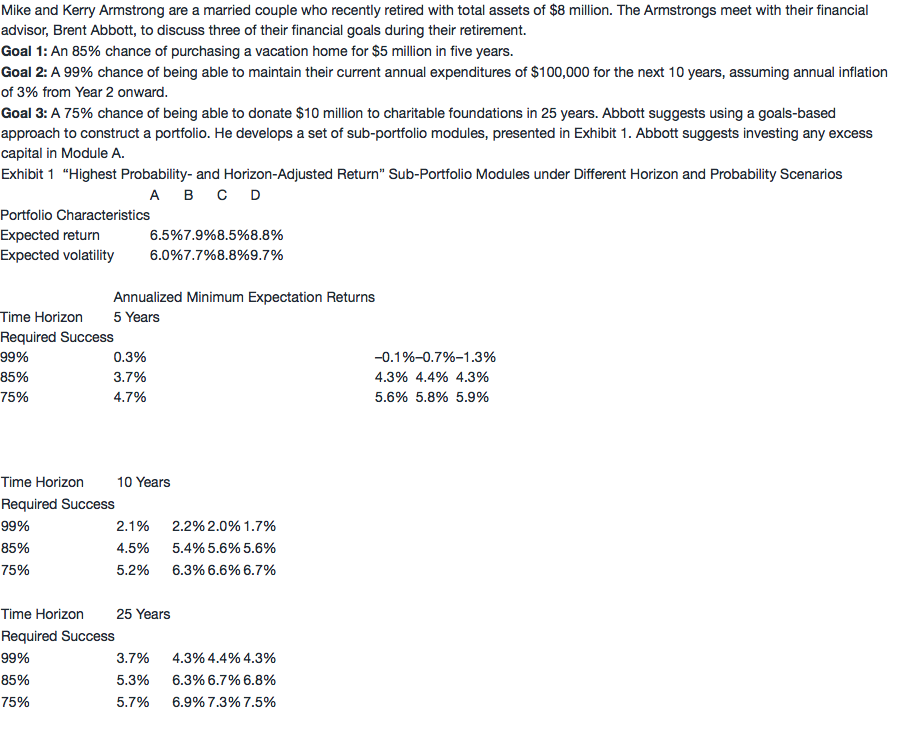NO.PZ201803130100000602
问题如下:
Mike and Kerry Armstrong are a married couple who recently retired with total assets of $8 million. The Armstrongs meet with their financial advisor, Brent Abbott, to discuss three of their financial goals during their retirement.
Goal 1: An 85% chance of purchasing a vacation home for $5 million in five years.
Goal 2: A 99% chance of being able to maintain their current annual expenditures of $100,000 for the next 10 years, assuming annual inflation of 3% from Year 2 onward.
Goal 3: A 75% chance of being able to donate $10 million to charitable foundations in 25 years. Abbott suggests using a goals-based approach to construct a portfolio. He develops a set of sub-portfolio modules, presented in Exhibit 1. Abbott suggests investing any excess capital in Module A.
Exhibit 1 “Highest Probability- and Horizon-Adjusted Return” Sub-Portfolio Modules under Different Horizon and Probability Scenarios
Construct the overall goals-based asset allocation for the Armstrongs given their three goals and Abbott’s suggestion for investing any excess capital. Show your calculations.

Show your calculations.
选项:
解释:
Guideline Answer:
■ The module that should be selected for each goal is the one that offers the highest return given the time horizon and required probability of success.
■ Approximately 16.4%, 12.7%, 50.4%, and 20.5% should be invested in Modules A, B, C, and D, respectively. The appropriate goals-based allocation for the Armstrongs is as follows:
Supporting calculations:
For Goal 1, which has a time horizon of five years and a required probability of success of 85%, Module C should be chosen because its 4.4% expected return is higher than the expected returns of all the other modules. The present value of Goal 1 is calculated as follows:
N = 5, FV = –5,000,000, I/Y = 4.4%; CPT PV = $4,031,508 (or $4.03 million)
So, approximately 50.4% of the total assets of $8 million (= $4.03 million/$8.00 million) should be allocated to Module C.
For Goal 2, which has a time horizon of 10 years and a required probability of success of 99%, Module B should be chosen because its 2.2% expected return is higher than the expected returns of all the other modules. The present value of Goal 2 is calculated as follows:
PV=$100,000/(1.022)1+$100,000(1.03)1/(1.022)2+$100,000(1.03)2/(1.022)3+...+$100,000(1.03)9/(1.022)10
PV = $1,013,670 (or $1.01 million)
So, approximately 12.7% of the total assets of $8 million (= $1.01 million/$8.00 million) should be allocated to Module B.
For Goal 3, which has a time horizon of 25 years and a required probability of success of 75%, Module D should be chosen because its 7.5% expected return is higher than the expected returns of all the other modules. The present value of
Goal 3 is calculated as follows:
N = 25, FV = –10,000,000, I/Y = 7.5%; CPT PV = $1,639,791 (or $1.64 million)
So, approximately 20.5% of the total assets of $8 million (= $1.64 million/$8.00 million) should be allocated to Module D.
Finally, the surplus of $1,315,032 (= $8,000,000 – $4,031,508 – $1,013,670 –$1,639,791), representing 16.4% (= $1.32 million/$8.00 million), should be invested in Module A following Abbott’s suggestion.
老师,计算PV时候,用的是BEN还是END模式?





